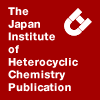

HETEROCYCLES
An International Journal for Reviews and Communications in Heterocyclic ChemistryWeb Edition ISSN: 1881-0942
Published online by The Japan Institute of Heterocyclic Chemistry

Special Issue
Yuichi Kanaoka's Special Issues, Vol. 59, No. 2, 2003
Published online:
■ A Facile Synthesis of 1,1-Disubstituted 1,2,3,4-Tetrahydro-β-carbolines via Trifluoroacetic Acid Catalyzed Pictet-Spengler Reaction Using Titanium (IV) Isopropoxide as an Imination Reagent
Yoshie Horiguchi,* Masayoshi Nakamura, Akiko Kida, Hirokazu Komada, Toshiaki Saitoh, and Takehiro Sano
*Showa Pharmaceutical University, 3-3165, Higashi-tamagawagakuen, Machida, Tokyo 194-8543, Japan
Abstract
A synthesis of 1,1-disubstitued 1,2,3,4-tetrahydro-β-carbolines (13) was achieved in a highly effective manner via the trifluoroacetic acid catalyzed Pictet-Spengler reaction of the keto imines (9) prepared from tryptamine (8) with acyclic and cyclic ketones using titanium(IV) isopropoxide as the imination reagent under one pot procedure. This reaction provides a convenient and general method for preparing various 1,2,3,4-tetrahydro-β-carbolines derivatives.
Published online:
■ Reaction of the α-Benzylic Anion of Spirophosphoranes with N,α-Diphenylnitrone: Stereochemistry and Formation of Hexacoordinate Phosphate Bearing a 1,2,5-Oxazaphospholidine Ring
Shiro Matsukawa, Yohsuke Yamamoto, and Kin-ya Akiba*
*Advanced Research Center for Science and Engineering, Waseda University 3-4-1 Ohkubo, Sninjuku-ku, Tokyo 169-8555, Japan
Abstract
The benzylic anion (3a-Li) α to the phosphorus atom generated from C-apical O-equatorial (O-cis) spirophosphorane (1a) reacted with N,α-diphenylnitrone to give hexacoordinate phosphates (8) bearing a 1,2,5-oxazaphospholidine ring. The phosphates were characterized by 31P NMR and by the structure of the products of protonolysis. Examination of the corresponding reactions from O-apical C-equatorial (O-trans) isomer (2a) revealed that the phosphates (9) derived from 2a were unstable compared with the hexacoordinated 8 derived from 1a, mainly due to the stabilizing trans influence of the P-O bond in 8.
Published online:
■ Practical Synthesis of A 3,4,4a,5,8,8a-Hexahydro-2H-isoquinolin-1, 6-dione Ring System by the Diels-Alder Reaction of an Optically Active Dienophile, a 5, 6-Dihydro-1H-pyridin-2-one Derivative, with Siloxydiene
Masako Nakagawa,* Hideharu Uchida, Koji Ono, Yoshiyuki Kimura, Mariko Yamabe, Takeshi Watanabe, Riichiro Tsuji, Masakatsu Akiba, Yukiyoshi Terada, Dai Nagaki, Sachiko Ban, Naoki Miyashita, Takuya Kano, Chumpol Theeraladanon, Keisuke Hatakeyama, Mitsuhiro Arisawa, and Atsushi Nishida*
*Graduate School of Pharmaceutical Science, Chiba University, 1-33 Yayoi-cho, Inage-ku, Chiba 263-8522, Japan
Abstract
An efficient method for preparing chiral 3-substituted-5, 6-dihydro-1H-pyridine-2-one (1) in large scale, based on a modification of our previous method, is described. The large scale Diels-Alder reaction of 1 with siloxydiene (2) to synthesize hexahydroisoquinolin-1, 6-dione, which is a key intermediate for the synthesis of manzamine alkaloids, was also studied.
Published online:
■ Photoreactions of 2- and 4-Pyridones in Their Inclusion Crystal with a Host Compound
Minoru Yagi, Shinya Hirano, Shinji Toyota, Fumio Toda,* Petros Giastas, and Irene M. Marvidis*
*Department of Chemistry, Faculty of Science, Okayama University of Science, 1-1 Ridai-cho, Okayama 700-0005, Japan
Abstract
Photoirradiation of a 2:1 inclusion crystal of 2-pyridone with biphenyl-2,2’-dicarboxylic acid in the solid state gave its trans-anti-dimer. Since photoirradiation of a mixture of biphenyl-2,2’-dicarboxylic acid and an excess of 2-pyridone in the solid state gave the trans-anti-dimer in a quatititative yield, it is clear that inclusion complexation of the two components occurs followed by photodimerization in the inclusion complex and that the host compound is used as a catalyst. However, a 2:2 inclusion crystal of 4-pyridone with rac-2,2’-dihydroxy-1,1’-binaphthyl was inert to the photoirradiation. Crystal structures of these inclusion compounds were studied by X-Ray analysis.
Published online:
■ A Structure for 261C, a Novel Tricylic Alkaloid from the Madagascan Poison Frog, Mantella betsileo
Tetsuo Kaneko, Thomas F. Spande, H. Martin Garraffo, Herman J. C. Yeh, John W. Daly,* Nirina R. Andriamaharavo, and Marta Andriantsiferana
*Laboratory of Bioorganic Chemistry, National Institute of Diabetes, and Digestive and Kidney Diseases, National Institute of Health, Bethesda, Maryland, 20892-0820, U.S.A.
Abstract
Based upon 1H-NMR, MS and IR spectra, a perhydro 2-allyl-5-ethyl-7-n-propylpyrrolo[2,1,5-cd]indolizine structure (1) is proposed for a major tricyclic alkaloid 261C isolated from skin extracts of a Madagascan poison frog of the mantellid genus Mantella.
Published online:
■ Fluorescence Lifetimes of Benzofurazan Adducts with Thiol Groups in Biomolecules
Yuko Yoshikawa, Mamoru Fujitsuka, Akira Watanabe, Osamu Ito,* Eisuke Sato, and Hiroshi Kokubun
*Institute of Multidisciplinary Research for Advanced Materials, Tohoku University, Aoba-ku, Katahira, Sendai 980-8577, Japan
Abstract
Fluorescence lifetimes have been measured for the adducts of ammonium 4-chloro-2,1,3-benzoxadiazole-7-sulfonate, which is known as a fluorescence probe specific to thiol groups. Although the adduct with simple molecule such as mercaptoethanol showed a single exponential fluorescence decay, most adducts with amino acid, peptide, coenzyme and protein showed the bi exponential decay. The fluorescence lifetimes and ratio of the short lifetime fraction to long lifetime fraction of the SBD adducts with biomolecules vary with the molecular size, solvent polarity and micro environment around the fluorescence probe.
Published online:
■ Chemo- and Stereoselectivity in 1,3-Dipolar Cycloadditions of Thiocarbonyl Ylides with a 1,4-Methanonaphthalene-5,8-dione Derivative
Grzegorz Mloston,* Malgorzata Celeda, and Heinz Heimgartner*
*Institute of Organic Chemistry, University of Zürich, Winterthurerstrasse 190, CH-8057 Zürich, Switzerland
Abstract
The reaction of 1,4,4a,8a-tetrahydro-1,4-methanonaphthalene-5,8-dione (2) with aliphatic and aromatic thiocarbonyl ylides (1a-c) gave polycyclic tetrahydrothiophene derivatives (5a-c) by a chemo- and stereo-selective 1,3-dipolar cycloaddition. The 1,3-dipoles (1a-c) were generated by thermal elimination of nitrogen from the corresponding 2,5-dihydro-1,3,4-thiadiazoles (4a-c).
Published online:
■ A Facile Access to 2-Ethynyl-1,4-dihydropyridines via Hantzsch Three-Component Reaction
Fridrich Szemes, Jr., Štefan Marchalín, Nadezda Prónayová, Fridrich Szemes, and Adam Daïch*
*Laboratory of Organic Chemistry, URCOM, EA 3221, Faculty of Sciences and Techniques, University of Le Havre, 25 Rue Philippe Lebon, BP 540, F-76058 Le Havre Cedex, France
Abstract
A new synthesis of 2-ethynyl-1,4-dihydropyridine derivatives in two steps from alkyl 3-oxo-5-trimethylsilyl-4-pentynoates via the Hantzsch three-component reaction followed by an alkaline hydrolysis is described.
Published online:
■ A Diastereocontrolled Route to (R)-(-)-Baclofen Using a Cyclopentanoid Chiral Building Block
Masato Hayashi and Kunio Ogasawara*
*Pharnaceutical Institute, Tohoku University, Aramaki, Aoba-ku, sendai 980-8578, Japan
Abstract
A diastereoselective route to the key intermediate lactone leading to a GABAB receptor agonist (R)-(-)-baclofen has been developed starting from (+)-4-cumyloxycyclopent-2-en-1-one via the 4-arylcyclopentenone intermediate.
Published online:
■ Asymmetric Horner-Wadsworth-Emmons Reaction Utilizing Isomannide and Isosorbide Derivatives as Chiral Auxiliaries
Shigeki Sano,* Rie Teranishi, Fumihito Nakano, Kyougetu In, Hiroe Takeshige, Takahiro Ishii, Motoo Shiro, and Yoshimitsu Nagao*
*Faculty of Pharmaceutical Sciences, University of Tokushima, Sho-machi, Tokushima 770-8505, Japan
Abstract
The diastereoselective Horner-Wadsworth-Emmons reaction of chiral phosphonates with σ-symmetric 4-tert-butylcyclohexanone and 4-phenylcyclohexanone was investigated by employing isomannide and isosorbide derivatives as chiral auxiliaries. α-Fluoro-α,β-unsaturated esters with an axis of chirality were obtained in diastereomer ratio up to 14 : 86 (aR : aS).
Published online:
■ Two New Cardenolide Glycosides from Streblus asper
Yoshio Hano,* Patima Juma, Zeper Abliz, Han-Dong Sun, and Taro Nomura
*Faculty of Pharmaceutical Sciences, Toho University, 2-2-1, Miyama, Funabashi, Chiba 274-8510, Japan
Abstract
Two new cardenolide glycosides, digitoxigenin-3-O-β- (3’-O-methyl)glucopyranoside (1) and 11, 19-dihydroxydigitoxigenin-3-O-β- (3’-O-methyl)glucopyranoside (2) were isolated from the underground part of Streblus asper, along with three known cardenolide glycosides. The structures of the new compounds were elucidated on the basis of the spectroscopic evidence.
Published online:
■ Studies on the Constituents of the Seeds of Vaccaria segetalis
Shengmin Sang, Zenghua Xia, Aina Lao,* Lin Cao, Zhongliang Chen, Jun Uzawa, and Yasuo Fujimoto*
*College of Pharmacy, 7-7-1 Narashinodai, Funabashi-shi, Chiba 274-8555, Japan
Abstract
Vaccaria segetalis is an annual herb widely distributed in Asia, Europe and North America. The seeds of this plant, known as Wang-Bu-Liu-Xing in traditional Chinese medicine, have been widely used to cure the diseases associated with women after giving birth. A wide range of chemical compounds including triterpene saponins, alkaloids, cyclic peptide, phenolic acid, flavonoids, and steroids have been isolated from the seeds of this herb. A comprehensive account of the chemical constituents and the biological activities are presented in this review.
Published online:
■ Transition Metal Complexation in 1,3-Dipolar Cycloadditions
Gianluigi Broggini, Giorgio Molteni, Alberto Terraneo, and Gaetano Zecchi*
*Università dell'Insubria, Dipartimento di Scienze Chimiche, Fisiche e Matematiche, via Valleggio 11, 22100 Como, Italy
Abstract
Transition metal complexation of organic molecules is becoming common in the field of 1,3-dipolar cycloadditions as a successful methodology to increase reactivities and to control selectivities. The literature data on this subject are here reviewed in a systematic way as a function of the different dipoles and principally of the stoichiometric or catalytic role of the metal containing reactants.